About Research Domains

- JST HOME
- SM4I HOME
- Research Domains Top
- Development of Ceramic Matrix Composites
[Main Text]
About Research Domains
The Center of Excellence at JFCC
Ceramic Environmental Barrier Coatings
(C41・C42)
Concept and Approach
We are developing the following technologies and methods in order to maintain Environmental Barrier Coatings (EBC) structure and Interfacial Control Coating structure, and Mechanical Properties (damage tolerance) of lightweight ceramics composites, even after prolonged exposure in an environment containing oxygen / water vapor at CMC service temperature of 1400 °C.
- 1) Optimum material design of multilayered ceramics coating film with excellent heat, water vapor and oxygen barrier properties
- 2) Development of EBC Technology to realize optimal multilayered ceramics coating film
- 3) Development of coating technology on the SiC fiber surface which constitutes a substrate inside of the composites
- 4) Understanding of usage limit of EBC coating and demonstration of the world highest level of material properties
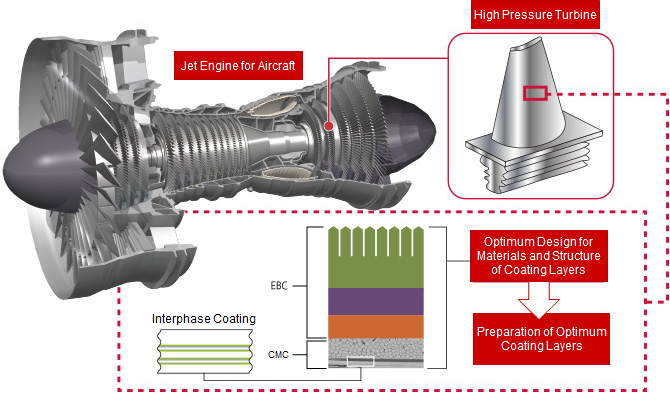
Research and Development
Development of Environmental Barrier Coatings (EBC) technology (C41)
Development of multilayered EBC technology / Environmental shielding design: AccomplishmentsJFCC
We have decided the EBC structure that makes it possible to use under severe high temperature environment which benchmark materials (practical stage materials) are difficult to apply, based on the mass transfer analysis in the EBC components.
We have also made it possible to estimate the amount of oxide ions and cations transferred through the grain boundaries of the EBC constituent layer under any "temperature and oxygen potential gradient".
Development of multilayered EBC technology / Double Electron Beam PVD method: AccomplishmentsJFCC
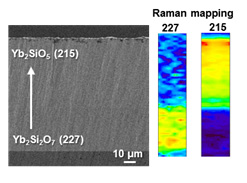
Example of Deposition by double electron beam PVD
We have established an element process to control the microstructure of complex oxide layer with high precision which is essential for the development of EBC performance.
For example, it has made it possible to form not only a dense structure which is vital for the gas shielding property, but also a pillar structure for imparting a graded composition and further thermal impact resistance.
Tie layered coating technology by CVD method: AccomplishmentTohoku University
We have succeeded in forming a coating film of a dense α-SiAlON layer using laser CVD method.
Tie layer coating technique by aerosol deposition method: AccomplishmentYokohama National University Faculty of Engineering
We have succeeded to form a dense layer of SiAlON as well as mullite on a lightweight ceramic substrate at room temperature by the aerosol deposition method.
Evaluation of applicability of coating material on actual equipment: Accomplishment IHI
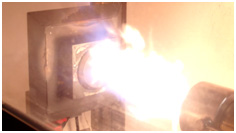
Implementation status of thermal cycle test
We have investigated the condition of the high temperature thermal cycle test using the burner rig equipment for the lightweight ceramics substrate and studied the jig structure, which made it possible to carry out 1000 times cycle test at about 1300 °C.
We have also obtained prospect of conducting the thermal cycle test at 1400 °C by improving the test specimen size and the testing machine.
Characterization of coating materials: AccomplishmentJUTEM
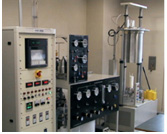
An exposure test equipment
under high temperature
humidity environment
We have designed and renovated an exposure test equipment under high temperature humidity environment for lightweight ceramics substrates with single phase constituent material of EBC multilayer film and multiphase laminate structure, and which made it possible to evaluate exposure in a humidified environment at 1400 °C.
EBC soundless evaluation and analysis: AccomplishmentNIMS
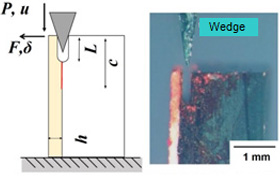
P, F: Test Load / u, δ: Load Displacement
L: Notch Length / c: Pre-crack Length /
h: Coating Thickness
We have devised a fracture toughness test for the interface of EBC multilayer film.
The interfacial fracture toughness is measured by applying this test to the existing EBC material which can be evaluated with a simple specimen using a general test apparatus without applying a load to a lightweight ceramic substrate with a weak interlaminar strength, which has helped demonstrated practicality. Furthermore, we are aiming to establish a test procedure in order to be accepted as a test that can become an industry standard.
Mechanical property evaluation of EBCTokyo Institute of Technology (TIT)
We have improved the nanoindentation test equipment and made it possible to conduct high temperature nanoindentation tests up to 600 °C for single phase components of EBC multilayer films. Furthermore, even in the nanoindentation test of high temperature (target 1000℃), we have clarified the technical problem on the required improvement for the equipment in order to measure the obtained data accurately.
Simulation of EBC fracture under mechanical and thermal loading: AccomplishmentThe University of Tokyo, Institute of Industrial Science, Center for Research on Innovative Simulation Software
In the process of preparing the EBC multiphase laminated film, it is necessary to design a structure which is exposed to a severe thermal cycle environment and does not cause crack development / propagation due to generated thermal stress and so on.
Therefore, we have developed an analysis system to predict the energy release rate of the multiphase laminate structure.

Development of Fiber Coating Materials (C42)
Development of fiber coating materials by CVD method: AccomplishmentYokohama National University Graduate School of Environment and Information Sciences
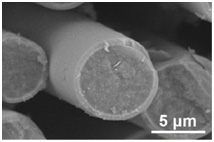 Yb silicate coating applied
Yb silicate coating applied
on SiC fiber bundle by CVD method
We have established a technology to form an Yb silicate layer using laser CVD method. We have also proposed and proved the technique to control the microstructure of the Yb silicate layer as well as the crack propagation path, and the technique to form SiC layer without using Si chloride, collaborating with JAXA, IHI and JFCC.
Evaluation of applicability of fiber coatingIHI
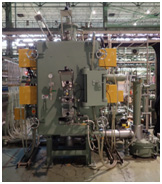 The Melt Infiltration furnace produced by IHI
The Melt Infiltration furnace produced by IHI
We have designed and produced a melt infiltration furnace capable of manufacturing a dense lightweight ceramic substrate, and investigated impregnation treatment conditions that will not damage fibers, and then we have made prototype ceramic substrate and evaluated impregnating property. In addition to this, we have selected a method of nondestructive inspection that can detect damage introduced to the ceramic substrate while using it, and we are working to optimize inspection conditions.
Design and microstructure analysis of fiber coating materialJFCC
We have clarified the thermochemical stability of Yb silicate based on the thermodynamic equilibrium calculation and model experiment, and have proposed the structure of fiber coating and its process conditions based on the obtained information.
Soundness evaluation and analysis of fiber coatingJAXA
We have evaluated the function of developed various coated fibers by mini composite and fiber punching method, and clarified the coating structure that demonstrates damage tolerance. As a coating, we have shown that CVD method is a more excellent fiber coating method than the chemical deposition one.
Development of ultrasonic inspection technologyThe University of Tokyo, Institute of Industrial Science, Department of Mechanical and Biofunctional Systems
We have confirmed that the nonlinear effect (generation of harmonics) of ultrasonic waves in lightweight ceramics composites increases after introducing of fatigue damage in the Feasibility Study conducted in FY2016. From now on, we will establish an indicator for quantitatively evaluating the change in nonlinear effect, and will construct a damage evaluation algorithm to make it easier to diagnose the degree of damage accumulation.
Development of ultrasonic inspection technologyTokushima University
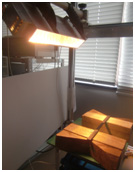 Active thermography test on ceramics samples
Active thermography test on ceramics samples
We have confirmed that the rate of the temperature rise during heating and the temperature decrease after heating change, before and after introducing fatigue damage, resulting of applying pulse thermography method on lightweight ceramics composites in the Feasibility Study conducted in FY2016. We will examine and optimize the influence of inspection conditions such as heat input amount and heating pulse time in the infrared imaging method measurement, and will establish an indicator for quantitatively evaluating the degree of damage.
Theme Structure and Role
Theme 1: Development of Environmental Barrier Coatings (EBC) technology (C41)
We are developing multi coating technology consisting of multilayer film based on optimal structural design of EBC coating.
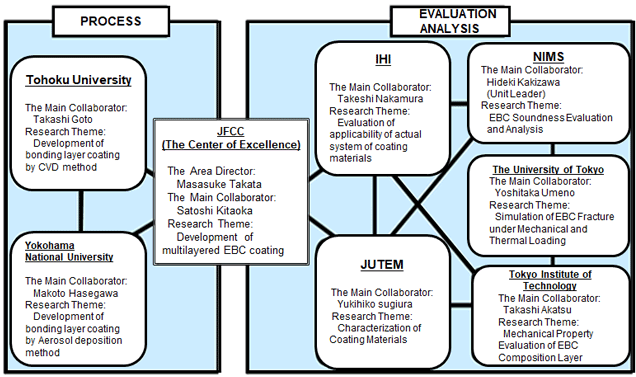

Theme 2: Development of fiber coating material (C42)
We are developing a process to coat Yb silicate on the surface of SiC fiber and producing a lightweight ceramic substrate using coated fiber.
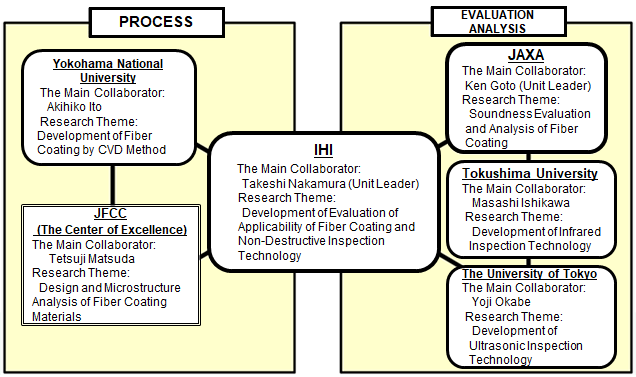
Breakthrough in Heat Resistant Use temperature at 1400 °C
Advanced structural design for optimization of environmental shielding and thermomechanical properties
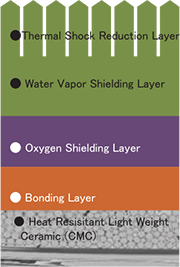
■ EBC with Multilayered Structure
It is crucial to reduce weight and improve heat resistance of hot section component in order to improve fuel efficiency of aircraft engines and to reduce CO2 emissions significantly. Although Ceramic Matrix Composites (CMC) is much lighter and superior in heat resistance than the current Ni based alloy, Environmental Barrier Coating (EBC), which protects the surface of composites and enables long-term use, is essential for applying it. It has a multi-phase laminated structure so as to have excellent environmental shielding and thermomechanical durability, and each layer has a distinctive function and overall it shows excellent performance.
The excellent environmental shielding is appeared by the dense film, but as a result, the constituent moves in the membrane and it becomes difficult to maintain laminated structure. In addition to structural design from perspective on previous material compatibility and thermomechanical properties, environmental shielding design based on quantitative and precise evaluation of mass transfer in EBC using high temperature gas permeation method etc. is extremely important in order to break down the current performance of EBC.
In this research, we propose an EBC structure that can be practically used for a long time under the combustion gas environment at 1400℃ by advanced structural design combining this environmental shielding design and thermomechanical structural design.
Understanding the limit of EBC use using the new fracture toughness evaluation method
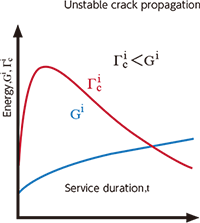
■ Evaluate usage limits of EBC
It is necessary to understand accurately the limit of EBC use and to operate it in order to improve the reliability of the aircraft engine, but the method has not been established yet.
In this research, we measure the fracture toughness of EBC after durability test under simulated use environment as well as calculate the energy release rate in consideration of the changes in properties of component materials. And we will propose a method to predict critical condition of EBC delamination and fracture which occur from temporal changes in these values caused by damage or structural change in use, and will also design EBC optimal structure using this method.
Regarding the measurement of fracture toughness, we will aim to establish a new test method that can reproduce the destruction mode with simple and compact specimen applicable to actual coating, considering future certification and standardization.
New EBC Multi Coating Technology
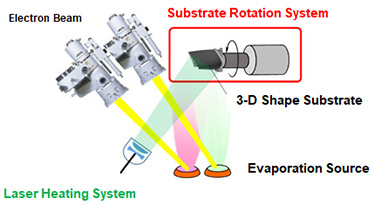
■ Conceptual diagram of film forming equipment for double electron beam (with substrate rotation mechanism)
We are developing process technology to form multiphase laminate structure EBC by electron beam PVD technique etc. based on advanced structural design.
The electron beam PVD technique is the mainstream film forming method in the thermal barrier coating of Ni-based alloy components for current aircraft engines.
In this research, it is possible to form composites oxides with significantly different vapor pressures, gradient and compositing of film composition by adopting a system consisting of multiple electron guns and raw material ingots.
We are aiming to realize a new EBC that can be stably used for a long time even in a combustion gas environment at 1400°C by using this technique.
Development of Advanced Melt Infiltration
for Ceramic Matrix Composites (CMC)
(C46)
Concept and Approach
We are developing CMC as high-speed and low-cost manufacturing process in order to reduce the cost of non-oxide CMC.
We are aiming to develop Advanced Melt Infiltration for CMC (Advanced MI) that shortens the time of MI (melt impregnation) which can process for a shorter time than CVI (chemical vapor infiltration) method or PIP (polymer impregnation calcination) method. We reduce the overall cost by utilizing general purpose of grade fiber which can suppress fiber deterioration by shortening the time that SiC fibers are exposed to hot molten Si.
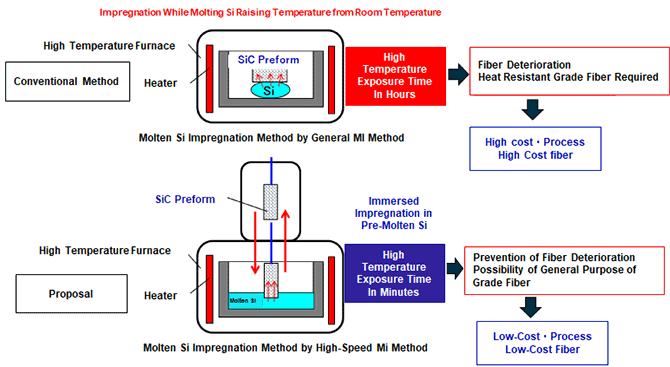
Unit Structure and Role
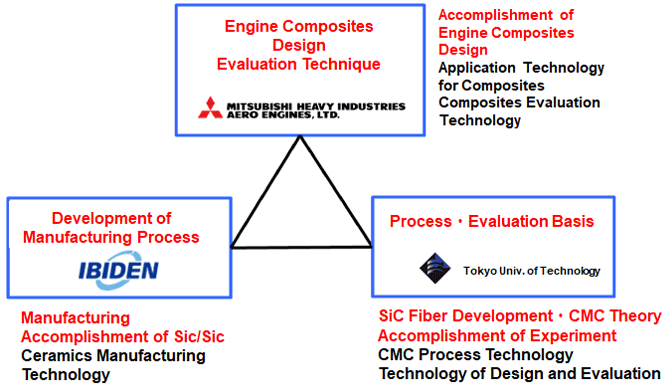
Research and Development
Establishment of Materials for CMC Blade manufacture / Design Request by Advanced MI Method
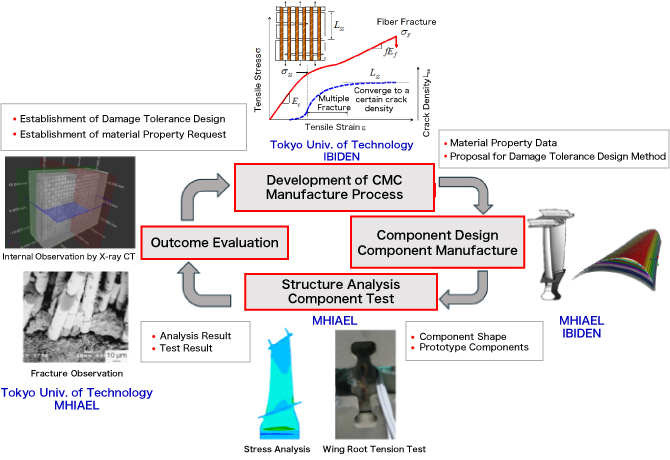
Development of Oxide Ceramic Matrix Composites
(C45)
Concept and Approach
We establish the toughness ceramic composites manufacturing technology which makes the conventional 3-D Woven Fabric Structure, Highly Heat Resistant SiC Fiber and CVI*, PIP** Repetitive Manufacture improve efficiently.
- (ⅰ) Establishment of CMC Manufacture Process
- (ⅱ) Improvement of heat resistance of oxide ceramics fiber
- (ⅲ) Development of the coating with functions of thermal barrier and abradable etc.
- (ⅳ) Establishment of Material / Structure Design and Evaluation Technology
* CVI:Chemical Vapor Infiltration
** PIP:Polymer Impregnation and Pyrolysis
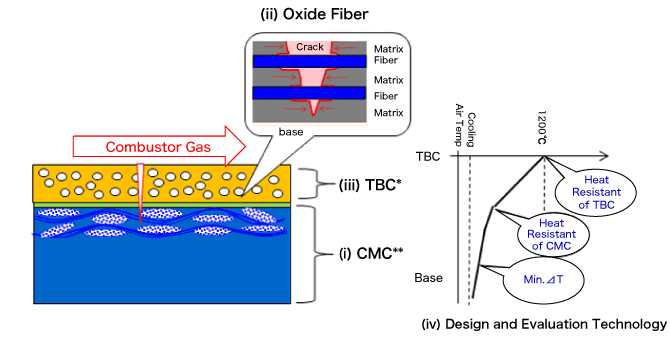
TBC:Thermal Barrier Coating , CMC:Ceramic Matrix Composites
Unit Structure and Role
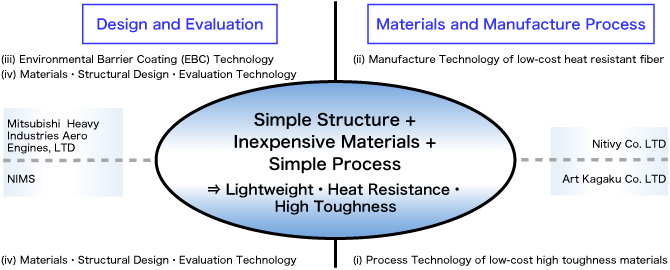
Research and Development
(ⅰ) Process Technology of Low-cost High Toughness Material
We have fabricated CMC using AI203 fiber with improved heat resistance and it has obtained high strength at three-point bending test and tensile test.
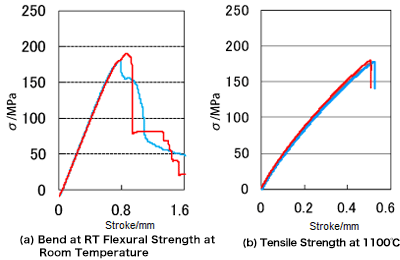
Example of CMC Strength Test Result
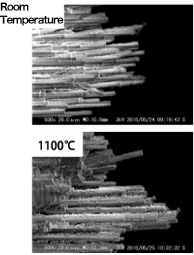
CMC Tensile Fracture Surface
(ⅱ) Manufacture Technology of Low-cost Heat Resistant Fiber
We have obtained oxide long fiber with improved heat resistance at 100 °C for the existing variety and fabricated a fabric using this textile.
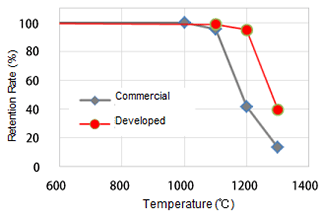
Example of Fiber Tensile Strength Retention Rate Measurement
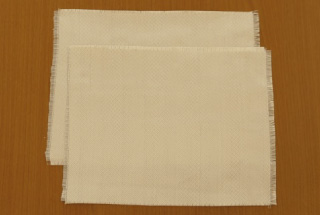
Alumina Long Fiber Fabric sample Prototype
(ⅲ) Environmental Barrier Coating (EBC) Technology
Optimization of topcoat materials with strong adhesion and abradable properties.

Cross Section of EBC
(ⅳ) Design for Material and Structure / Evaluation Technology
Improvement of fracture characteristics by applying thin CMC coating on ceramic substrate.
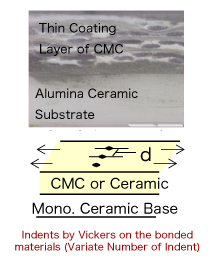
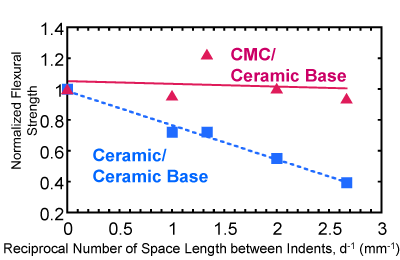
3-point flexural strength of CMC after Vickers indentation vs reciprocal number of space length between indents
We have designed shroud and extracted problems.
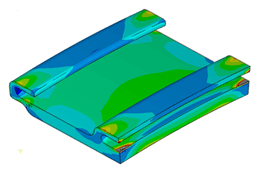
Structural Analysis Example of Shroud Design
List of R&D Projects and Units
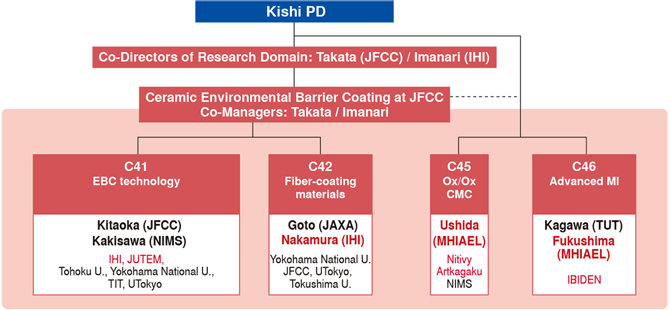
| No. | R&D Project | Research Unit | Unit Leader |
|---|---|---|---|
| C41 | Structural Optimization and Reliability Improvement of Ceramic Environmental Barrier Coatings | Development of Environmental Barrier Coatings (EBC) Technology | Satoshi Kitaoka (JFCC) Hideki Kakisawa (NIMS) |
| C42 | Development of Fiber Coating Materials | Takeshi Nakamura (IHI) Ken Goto (JAXA) |
|
| C46 | Development of Advanced Melt Infiltration for Ceramic Matrix Composites (CMC) | Yutaka Kagawa (TUT) Akira Fukushima (MHIAEL) |
|
| C45 | Development of Oxide Ceramic Matrix Composites | Masanori Ushida (MHIAEL) | |
